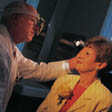 Skull-base surgery team weaves tapestry of survival The lights are dimmed in this seventh-floor conference room late on a Monday afternoon. Singly, a dozen or so white-coated, scrub-clad doctors and nurses wander in, seemingly without intent. Their scattered talk of new and continuing patients subtly metamorphoses into more deliberate case presentations and analyses of approaches and outcomes. Neuroradiologist Bill Nemzek lowers the slide screen and begins to illustrate the discussions with the ghostly images of CT and MRI scans, pointing to the shadows and specters that are threatening to transform dynamic lives into untimely deaths. Ideas are proffered, approaches explored. From this unstructured exploration emerges a strategy for each patient: maybe surgery, maybe some radiation and chemotherapy, maybe just supportive comfort care. The common denominator underlying every exchange is hope - hope that this team of highly trained and deeply committed doctors and nurses can weave their varied talents together to create a tapestry of survival and an acceptable quality of life for each patient. This is the skull-base surgery team at UC Davis: neurosur- geons, otologists, head and neck surgeons and plastic surgeons; pathologists, radiologists, oncologists, acute-care nurses, and clinical nurse specialists; speech therapists, audiologists and dentists. It is a vital component of the growing cancer program here. Each member brings special knowledge and skills to bear on the most complex cases of cancer, those that have gained a sure and certain foothold in one or more of the labyrinthine crevices of the lower skull. Sinuses, eye sockets, nasal passages, ear canals, jaws, palates and, yes, brains.
Home |
Table of Contents |
To our Readers |
Building on Basics UC Davis Health System | © 2000, 2001, 2002 UC Regents. All rights reserved. |
  |
